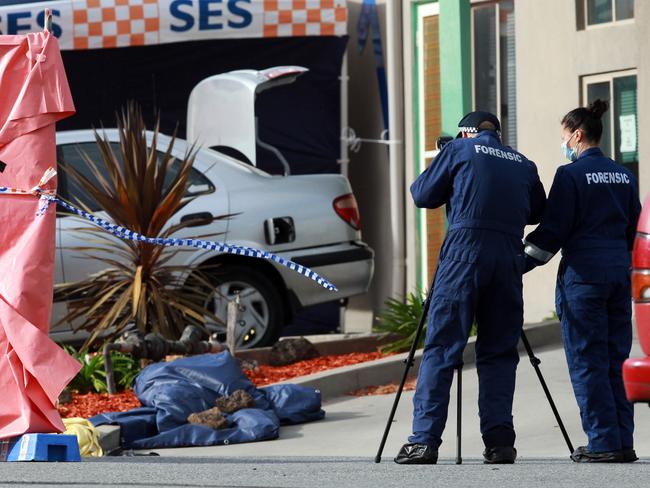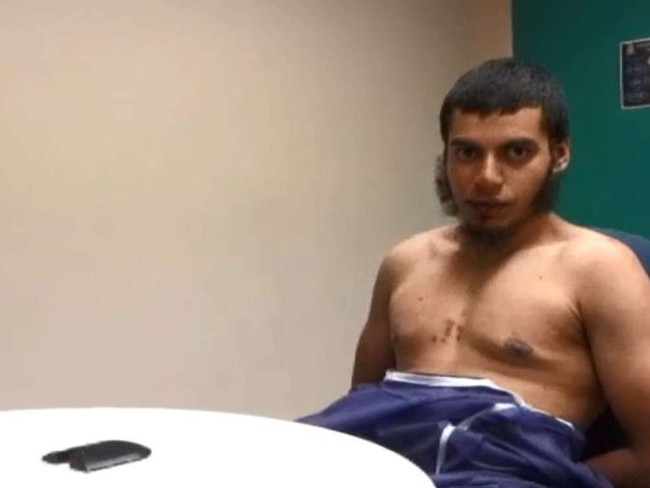Explained: What new Aussie terror threat level means for you
Anthony Albanese has raised Australia’s terror threat level amid concerns about extremist behaviour. Here’s everything you need to know about what it means.
National
Don't miss out on the headlines from National. Followed categories will be added to My News.
Australia’s terror threat level has been raised from “possible” to “probable”. Here’s what it means.
WHAT HAS CHANGED WITH THE TERROR THREAT?
The Australian government uses a five-step colour-coded scale to warn the public of terrorism threats: from not expected (green), to possible (blue), to probable (yellow), and then expected (orange), and then certain (red).
In a press conference in Canberra on Monday, August 5, Prime Minister Anthony Albanese and ASIO director general Mike Burgess announced the threat level was moving from “possible” to “probable”.
This means authorities believe there is a greater than 50 per cent chance of an attack or planning within the next 12 months.
Along with other western nations, Australia adopted a colour-coded terror threat advisory system in the mid-2000s.
The set level is reviewed when deemed necessary rather than on a cyclic basis.

WHY WAS THE TERROR THREAT CHANGED?
In today’s announcement, Mr Burgess said the decision reflects a “degrading” security environment, which was becoming “more volatile and more unpredictable”.
Social cohesion was “deteriorating,” he said.
The decision comes after eight terror plots were investigated in the past four months.
No recent terror plots in Australia have been directly connected to the current situation in the Middle East, but that conflict could escalate local tensions.

ASIO said it has observed “the emergence of domestic actors increasingly driven to action by sociopolitical issues, intersecting with personal grievances”.
“There is an increase in extremism, fuelled by conspiracy theories and anti-authority ideologies. Some actors hold a blend of ideologies, including those that justify acts of violence to influence change.”
Social media was acting as both a “gateway” for “violent ideologies” and “a key driver of volatility,” ASIO said.
James Morrow, national affairs editor at The Daily Telegraph, said the war in Gaza “is widely considered a key driver to the increased alert levels”.
The rise in anti-Semitic incidents, demonstrations, and the blockades of government offices including the Prime Minister’s own electorate office, would also have factored into ASIO’s decision making, Mr Morrow said.
HAS AUSTRALIA BEEN ON ‘PROBABLY’ TERROR LEVEL BEFORE?
Indeed it has. Security agencies raised Australia’s threat level to “Probable” from “Possible” in 2014, and the rating stayed that way until November 2022.
Today’s announcement moves us back to the position we were in before November 2022.
At the time the then Minister for Home Affairs, Clare O’Neil, said: “The lowering of the threat level does not mean the threat from terrorism is extinguished.”
WHAT HAPPENS NEXT?
While the threat level has been raised, don’t expect to see your civil liberties curtailed overnight or armed guards on city streets.
First and foremost, said ANU terrorism expert Dr Michael Zekulin, the raising of the terror alert is a signal to the Australian public “to be a little more vigilant about what they’re seeing, and what they’re hearing” and report any incidents to the authorities.
Monday’s announcement will also put other agencies tasked with public safety on notice to be more vigilant about terror threats, which could lead to reviews of protocols for major events, Dr Zekulin said.
The Australia government’s online information about the terror threat level states that any local attacks are likely to be by a lone wolf or a small group, using low-cost tactics and readily-available weapons including knives, vehicles, explosives, and firearms.
While concerns about online radicalisation and exposure to extreme content are increasing, Dr Zekulin said it was unclear what pressure the government could exert on the tech giants to ensure content was being moderated.
Facebook declined to comment; responses were being sought from Google, X and TikTok.
If the authorities obtain information about a specific threat, the terror level warning could be raised to expected (orange) or even certain (red) – levels that Australia has never been at before.
DO AUSTRALIANS NEED TO WORRY?
While ASIO has stated the most likely location for a terrorist attack are crowded public events, or places such as shopping centres, transport hubs and places of worship, Dr Zekulin stressed that such terrorism incidents in Australia were still “very, very rare”.
“It’s not a question of changing the way you live your life, or anything like that,” he said.

James Morrow concurred.
“Australians should not be generally more alarmed about the threat of being a victim of a terror attack in their day to day lives,” he said.
“However the heightening of the alert level will have law enforcement agencies and security agencies working overtime, behind the scenes.”
Suspicious activity can be reported to the National Security Hotline on 1800 123 400, via email on hotline@nationalsecurity.gov.au or via SMS on 0429 771 822.
TIMELINE OF TERROR IN AUSTRALIA
2005
June
Australia’s largest terrorism investigation Operation Pendennis identifies extremist terror cells in Sydney and Melbourne.
The Melbourne cell was plotting to bomb the MCG (AFL Grand Final), Grand Prix or Crown Casino.
The Sydney cell was planning to attack the electricity grid or defence sites.
2009
August
Melbourne men Wissam Fattal, Saney Edow Aweys and Nayef el-Saye convicted of planning to conduct a mass shooting at Holsworthy Army Base in Sydney.
2014
September 19
Police carry out raids in Brisbane and Sydney, arresting more than a dozen involved in a plot to kidnap a random member of the public and behead them on camera.
September 23
Abdul Numan Haider, 18, stabs two counter-terrorism officers in Endeavour Hills, Melbourne, before he was shot dead.

December 15
Man Haron Monis holds 18 hostages at gunpoint at Lindt Cafe in Sydney’s Martin Place.
The siege ends with the death of two hostages and Monis himself.
2015
February 10
Sydney men Omar Al-Kutobi and Mohammad Kiad plot to target a Shia mosque.
April 18
Melbourne teen Sevdet Ramadan Besim plots to behead a police officer on Anzac Day.

May 8
An unnamed 17-year-old man plans to detonate bombs at a Mother’s Day event in Melbourne.
October 2
Fahad Mohammed, 15, fatally shoots Sydney police accountant Curtis Cheng outside the Parramatta police headquarters. Police shoot Mohammed dead.
December 10
Five offenders charged with terrorism related offences in Sydney.
2016
January 25
A male and female plot to conduct a knife attack at Parramatta Westfield.
April 24
A 16 year old attempts to acquire a firearm for an alleged terrorist act targeting Anzac Day ceremonies.
May 17
Tamim Khaja, 18, sentenced to 19 years for planning and preparing a “lone wolf” terrorist attack either at the US consulate, an army barracks or at Parramatta Court.

June 14
A 17 year old Sydney teen with autism allegedly plans a terrorist attack potentially involving a knife on a police officer.
August 6
Melbourne Right wing extremist Phillip Galea is found guilty of plotting terror attacks against “left wing” targets including Trades Hall.
September 10
Ihsas Khan, 22, stabs a 59-year-old man in southwest Sydney, stating “these people are killing my brothers and sisters in Iraq”.

October 12
Two 16-year-old boys allegedly prepare to behead a person in Sydney’s southwest.
December 11
Ahmed Mohamed, Abdullah Chaarani and Hatim Moukhaiber torch the Imam Ali Islamic Centre in Victoria.
December 23
Ahmed Mohamed, brothers Hamza Abbas and Ibrahim Abbas, and their cousin Abdullah Chaarani, plot to conduct an attack in the CBD on Christmas Day.
2017
June 5
Yacqub Khayre, 29, murders a receptionist and holds a sex worker hostage in Brighton, Victoria. Khayre is killed by police.

June 14
Sydney man attempts to stab a police officer in order to ‘further the course of Islamic terrorism’.
July 29
Brothers Khaled and Mahmoud Khayat plot to bring down a plane with an improvised explosive device.
November 27
Ali Khalif Shire Ali, 20, charged after allegedly trying to undertake a terrorist attack in Melbourne’s Federation Square on New Year’s Eve.
2018
February 9
Bangladeshi Islamist Momena Shoma stabs a 56-year-old man in the neck while he was asleep at his Mill Park home in Victoria.
November 9
Hassan Khalif Shire Ali sets his vehicle on fire and stabs three people, one fatally, on Melbourne’s Bourke Street. He is shot dead by police.
2019
July 2
Self-declared ‘Commander of IS in Australia’ Isaak el Matari plots to create a stronghold in the Blue Mountains and direct fighters to conduct ‘guerrilla’ attacks in various Sydney locations.
2020
March 14
21-year-old man arrested by JCTT-SO, intending to replicate Christchurch attacks.
He had been practising detonating explosives and conducting reconnaissance on mosques.
October 30
Victorian female prisoner Momena Shoma charged with committing a terrorist act after stabbing a fellow inmate with a pair of garden shears.
She was already serving 42 years in prison for engaging in a terrorist act after she stabbed her landlord with a kitchen knife.
November 27
Queenslander sought firearms training for an alleged terrorist act in the Bundaberg region.
December 17
Raghe Abdi, 22, fatally shot by police on Brisbane motorway after killing elderly couple in their home.
2021
November 28
40-year-old man shot at passing cars and pedestrians in Windang, NSW, before barricading himself inside a nearby dive shop.
2024
April 15
A 16-year-old allegedly stabbed Assyrian Bishop Mar Mari Emmanuel in western Sydney during a livestreamed service.
May 5
Police shot dead a 16-year-old boy who stabbed another man with a kitchen knife in Perth, saying the teenager was “radicalised” online.
Jordan Patten, 19, charged with a terrorism offence after he intended to kill Newcastle Labor MP Tim Crakanthorp.
July 2
A 14-year-old boy dressed in a camouflage military uniform allegedly stabs a student in the neck on the University of Sydney campus.



